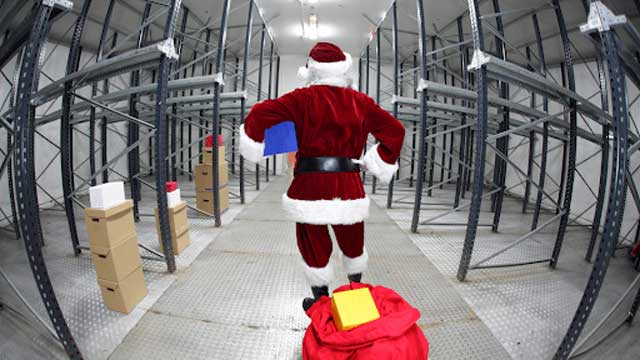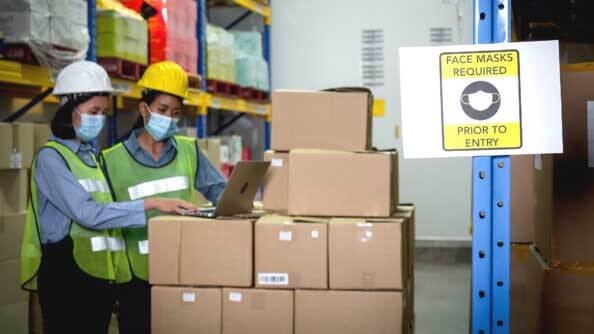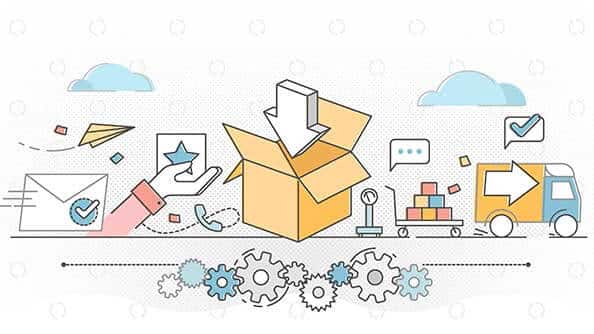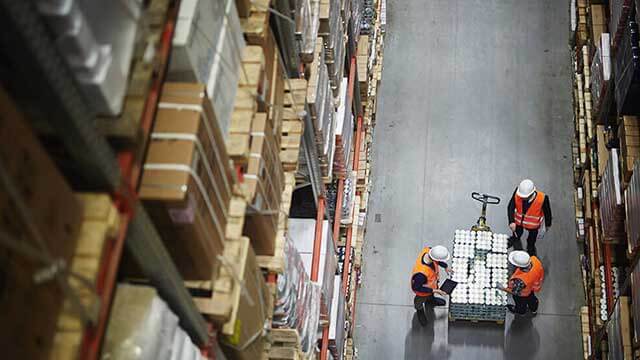Blog Topics

3 Reasons Why Choosing a Midwest Fulfillment Service is Smart for Business
Ah, the Midwest. This region not only offers scenic beauty and a relaxed lifestyle, but it’s also becoming a hub for Midwest fulfillment services. The Midwest is considered one of four census regions in the United States and is home to almost 69 million people (21% of the US population)...
Read MoreCategories: General Order Fulfillment Shipping Solutions

Overcome Employee Turnover: 6 Key Factors Influencing Employee Retention Decisions
Are you struggling with employee turnover in the logistics industry? In this in-depth blog post, we explore the key factors that influence employees' decisions to stay at their jobs or seek new opportunities. From the impact of the COVID-19 pandemic to the Great Resignation, we examine the latest labor statistics and insights from the Voice of the Blue-Collar Worker survey. Discover the top priorities for employees and learn effective strategies to retain top talent, boost satisfaction, and create a thriving work environment. Don't miss this valuable resource for navigating the complex world of employee retention in logistics.
Read MoreCategories: Covid Order Fulfillment Supply Chain Logistics Supply Chain Workforce Management

Recognizing the Benefits of Using Robotics in Fulfillment Centers
Robotics for fulfillment centers and third-party logistics (3PL) providers has been to get goods from warehouse to customer in the fastest, most efficient way possible, without sacrificing quality of service.
Read MoreCategories: Order Fulfillment Supply Chain Technology Supply Chain Workforce Management

Fulfillment Centers Employ Supply Chain as a Service (SCaaS) and Cloud Computing
Managing the supply chain is one of the most important functions of a successful business, but skillfully executing it in-house can be a challenge. Outsourcing all or a part of this management, by partnering with a third-party logistics (3PL) company, can help improve efficiency, accuracy, and flexibility, while reducing costs.
Read MoreCategories: Supply Chain Efficiency Supply Chain Technology Warehouse Management

Impact of Blockchain on Fulfillment Centers
Mention the word “blockchain” are you’re likely to get one of several reactions. Some people have embraced this new technology and are very enthusiastic about it. Others are skeptical that it will live up to its hype and recommend caution. Many are confused and don’t understand it.
Read MoreCategories: Order Fulfillment Supply Chain Technology

Sustainable Logistics Solutions: Paving the Way for Greener Business Practices
A new year - new resolutions and new ideas. Becoming greener will probably be on the list of most everyone. Companies and consumers are concerned about the effects our actions are having on the earth and are looking for sustainable solutions.
Read MoreCategories: General Goals Packaging Shipping Solutions

4 Ways to Succeed at Attracting and Retaining Star Employees
Help Wanted. The sign beckons and pleads. It’s everywhere you look – your favorite restaurant, the bank, the grocery, even your own place of employment. The current labor shortage is just one of the many consequences of the COVID-19 pandemic, but it is having a devasting impact on the economy.
Read MoreCategories: General Supply Chain Workforce Management Warehouse Management

Caution: Rocky Holiday Road Ahead
Businesses are gearing up for the busy holiday season. This one could be a bumpy ride. They are cautioning that the mantra “order early” is especially important this year. There are several forces in play that will likely significantly impact the cost of products and the rate at which they can be delivered...
Read MoreCategories: General Supply Chain Logistics Supply Chain Workforce Management

Medium Sized Logistics Companies May Be Just the Right Fit
Contrary to popular opinion, bigger is not always better. This may be particularly true when it comes to choosing a third-party logistics (3PL) provider. Large companies may be too distracted to give you the customized attention you need. Smaller companies may struggle to provide necessary products and services. A mid-sized company may be just the right fit. Below are some of the advantages of that choice.
Read MoreCategories: Supply Chain Efficiency Supply Chain Logistics Warehouse Management

Understanding Importance of Customer Experience in Logistics Industry
It seems that every industry is buzzing about customer experience (CX), and with good reason. Whether it be on-line, over the phone, or face-to-face, these exchanges give you the opportunity to put your best foot forward. Delivering exceptional customer service should be a priority for every business. Here we talk about how this applies to the logistics industry.
Read MoreCategories: Goals Partners Supply Chain Logistics

3 Ways to Improve Your Forecasting and Planning
The COVID-19 pandemic has been a major disruptor of the logistics industry, with shortages and delays being the norm over the past year. Many companies are still not in full recovery. Moving forward, those companies that can take a fresh look at how they forecast and plan, stand the best chance of remaining viable. Here we will explore three ways to do that.
Read MoreCategories: Pandemic Supply Chain Efficiency Warehouse Management

3 Ways Omni-Channel is Transforming the Logistics Industry
Omni-channel is a hot topic right now, but what does it mean? If you look up “omni” in a dictionary it is defined as all/everywhere. Applying this to logistics means that you can tailor the process to meet the needs of individual customers. Third Party Logistics (3PL) companies that are doing business in this fashion are transforming the industry. There are three areas where this true.
Read MoreCategories: Supply Chain Efficiency Warehouse Management

5 Ways to Turn Your Warehouse into a Well-Oiled Machine
To see a warehouse running like a well-oiled machine is a thing of beauty. It seems that it would be simple enough to achieve, but there are numerous areas where breakdowns in the process can occur. Learning what to look for, and ways to improve and even optimize operations, is possible. Warehouse efficiency, as well as good warehouse real estate management, is attainable with a focus on the following five key areas.
Read MoreCategories: Supply Chain Efficiency Warehouse Management

Should Your Fulfillment Center Be Striving for 100% Inventory Accuracy?
Everyone in your company has likely experienced the difficulty of inaccurate inventory—from the warehouse picker staring blankly at a bin that shouldn't be empty to the customer service rep explaining to distressed customers that their items are backordered. It's a natural part of doing business, right? Not entirely. Inventory accuracy may be a moving target, but it doesn't mean you can stop aiming for it.
Read MoreCategories: Supply Chain Logistics

COVID One Year Later: How Have You Adapted?
It has now been one year since COVID-19 was declared a pandemic. To say that it has been a challenging time is an understatement. Disruptions and restrictions were common. Shortages and delays were the norm. Moving forward, those companies that have found ways to adapt will thrive. A focus on the areas discussed below will become even more valuable as circumstances continue to change.
Read MoreCategories: Covid Pandemic Supply Chain Workforce Management Warehouse Management

5 Potential Pitfalls to Using 3PL And How to Avoid Them
Third-party logistics (3PL) is a multi-billion dollar industry. Most of the Fortune 1000 companies use some sort of 3PL services; but for your business, you may be questioning whether the timing is right for you to take the plunge. The decision to contract with a fulfillment partner is a big one.
Read MoreCategories: Partners Reverse Logistics Shipping Solutions Warehouse Management

4 Factors to Maximizing Supply Chain Efficiency
When fulfilling your e-commerce orders, supply chain efficiency plays a major role within the warehouse. Your supply chain performance measurements may fundamentally differ from day to day, depending on which facets need work. Many factors — both inside and outside the warehouse play a professional tug of war with your goals and intentions, requiring constant adjustment just to maintain the status quo.
Read MoreCategories: Supply Chain Efficiency Supply Chain Technology

5 Questions to Ensure your Fulfillment Center is “Holiday Rush” Ready
With e-commerce fulfillment centers facing down a proverbial tide of year-end business, productivity and efficiency soar to the top of managers' wish lists. How do you fulfill your e-commerce orders and give these must-have gifts to your managers? Here are five ways to prepare for the winter storm of orders without breaking a sweat or investing in expensive new warehouse technology:
Read MoreCategories: General

The Best Order Fulfillment Partner: 3 Factors To Narrow Your Search
With all the complexities of order fulfillment, there is no overall winner suited for every company. Considering all the areas of expertise, the right provider for one business may be the wrong provider for your business. So what is a conscientious supply chain manager to do?
Read MoreCategories: Ecommerce Fulfillment Order Fulfillment Partners

How to Improve Warehouse Picking Process Efficiency
As a warehouse manager, you know how essential warehouse picking is in the supply chain. At Aero, getting your orders out on time means careful planning of all warehouse activities. Order picking is one area where inefficiencies take a serious bite out of the bottom line.
Read MoreCategories: Order Fulfillment Warehouse Management

What is Pick and Pack Warehousing and How is it Beneficial?
What is picking and packing? Warehouse Picking Warehouse fulfillment starts with finding the relevant stock so that it can be properly packed. The Pick and Pack Warehouse may choose to automate this process to save time and reduce labor costs. Without a great inventory management system in place, there's no way to make the pick packing efficient.
Read MoreCategories: Order Fulfillment Warehouse Management

Guide to the Different Order Picking Systems & Methods in a Warehouse
Your warehouse management system is an integral component of your business, especially if you run an eCommerce business. Customer satisfaction depends on how efficiently you can process orders. If your warehouse picker takes too much time walking from one place to another, chances are you won't deliver your customers' orders on time. When you work with Aero, you will get guaranteed quality service within your warehouse.
Read MoreCategories: Ecommerce Fulfillment Packaging Warehouse Management

Fulfillment Center vs. Distribution Center: How are they Different?
When setting up an eCommerce business, one of the most important things to consider is how your customers will get their orders. You have two warehouse options to choose from - fulfillment centers and distribution centers. A distribution center and a fulfillment center both store and ship product. So, the terms are often used interchangeably when talking about logistics and supply chain management.
Read MoreCategories: Order Fulfillment Warehouse Management

What’s the difference between Warehousing and Fulfillment?
Partnering with Aero's warehousing and fulfillment centers frees up your time and worry, so you can focus on what you do best - growing your businesses. Our fulfillment warehouse takes care of inventory management, packing, and shipping, leaving you more time for product development, marketing and sales.
Read MoreCategories: General

Ramping Up Post-COVID: Ensure Your Fulfillment Plan is Ready for Restart
During this time when the coronavirus pandemic caused many businesses to close or slow down, you might have discovered some weaknesses and risks in your supply chain. You might even have new priorities. As we all begin to ramp business back to full capacity, now may be a good time to take a look at your logistics and maybe revamp a few things to make sure your fulfillment plan is ready for a restart.
Read MoreCategories: Covid Goals Pandemic Supply Chain Logistics

The Hidden Pitfalls of In-Store Fulfillment
Offering a variety of options to get items to customers is good business, but keeping everything in one place might not be the best idea. With the goal of saving money and consolidating inventory, many stores are turning to in-store fulfillment. The practice has its drawbacks.
Read MoreCategories: General Order Fulfillment

Automating Your Fulfillment Center is Key to Optimizing Your Supply Chain
Businesses which fall into the trap of putting too much focus on manufacturing and inventory costs are being held back from their full potential as they fail to acknowledge the inefficiencies arising through weak links in the supply chain.
Read MoreCategories: Supply Chain Efficiency Supply Chain Technology

When Is It Time to Say Goodbye?
Parting may be sweet sorrow, in interpersonal relationships, according to the Bard, but in business it can be what saves your company. Vendor management best practices place a great deal of focus on how to manage and optimize the existing relationships your supply chain depends on, but they may fall short on guidance when it comes to enough is enough and it is time to break things off with an underperforming vendor.
Read MoreCategories: Vendors

A Complete Guide to Third-Party Warehousing & Distribution for Retailers
Millions of retailers have become etailers as more and more shoppers choose to make their purchases online. Smart Insights estimates that consumer spending over the Internet accounted for $3.5 trillion in sales in 2019 and will pass $4.2 trillion in 2020. The research company projects that online customers will spend $6.5 trillion in 2023. Online sales are growing at an annual rate of about 15 percent, increasing the need for many third party warehouses.
Read MoreCategories: Ecommerce Fulfillment Order Fulfillment Warehouse Management

What is Order Processing Fulfillment: Defining and Improving it
Order processing fulfillment involves each individual step a business or organization takes from the initial point of receiving an order to getting that order to the customer. It is the way that each organization responds to and ultimately fills an order.
Read MoreCategories: Order Fulfillment

3PL Fulfillment Services or a Warehouse Investment
As your ecommerce business grows so does your operations need to evolve to meet the changing demands of your business. In running an ecommerce business; fulfillment logistics is one of the most important aspects. You need to reconsider your fulfillment logistics strategy every so often as your ecommerce business expounds.
Read MoreCategories: Ecommerce Fulfillment Order Fulfillment

Peak Season Returns: Reducing Your Cost
Peak Season Returns: Reducing Your Cost. Overall, holiday’s sales this year appear to have been robust, with Mastercard reporting total retail sales were up 3.4% year-over-year for the period of November 1st to December 24th. Online sales represented 15% of the total, with total e-commerce sales up 19% over last year.
Read MoreCategories: Reverse Logistics Supply Chain Logistics

4th Quarter Freight
Any company with a D2C ecommerce model is well aware of the increasing challenges of managing fulfillment, in particular, freight costs during the fourth quarter. Consumer shipping expectations continue to rise driven by the fulfillment benchmark being set by Amazon, Walmart, and other large D2C companies.
Read MoreCategories: Ecommerce Fulfillment Order Fulfillment Shipping Solutions

Don’t Let These Peak Season Issues Haunt You
It is easy to get spooked this time of year. The weeks leading up to peak season can be scary, but peak will be even scarier if you don’t have the right partner. The holiday season is almost upon us and customers are ready and will test the mettle of your supply chain.
Read MoreCategories: Ecommerce Fulfillment Order Fulfillment Supply Chain Logistics















